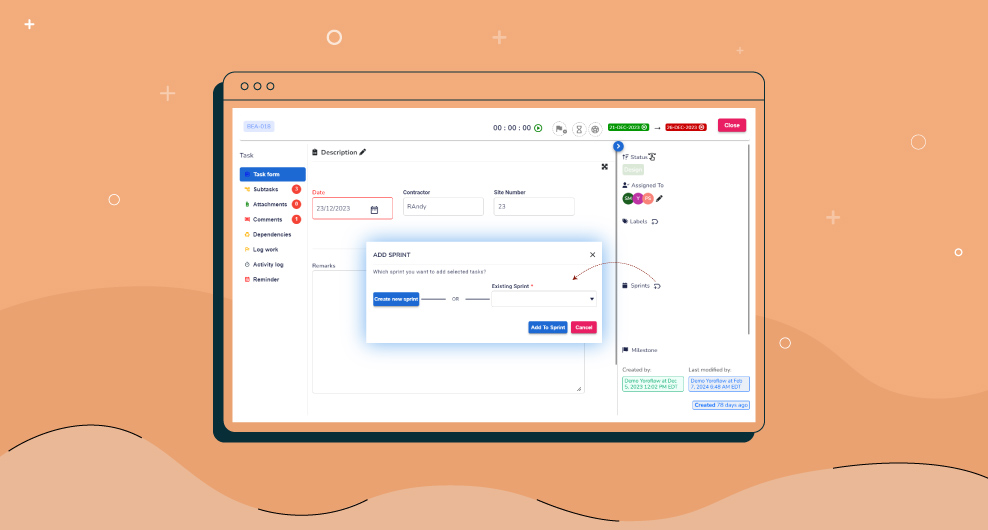Table of Contents
Software development involves various tasks that must be completed within an estimated time frame. Each task should be monitored, and the reports should be submitted. To complete the project on time, some metrics should be calculated to split the subtasks with proper time limits. This is where a metric like sprint velocity can help set achievable targets and gain visibility into the process.
This article explores sprint velocity, the fundamentals of sprint velocity, strategies for improving sprint velocity, and tools to keep your project on track
Sprint velocity
Sprint velocity is a metric used in Agile project management to measure the amount of work a team can complete in a sprint, typically measured in story points or other relative units. It helps teams understand their capacity for work and can be used to forecast future work completion. Velocity is often calculated by adding up the story points of all completed user stories in a sprint. This metric is useful for teams to understand their capacity for work and to make informed decisions about what can be accomplished in future sprints.
The foundations of sprint velocity
The foundations of sprint velocity lie in understanding the core principles of agile methodology and how they translate into measurable progress within a sprint. Here are the key elements:
Agile Principles: Sprint Velocity is a metric used in Agile project management that is guided by the Agile Manifesto and its twelve principles. These principles emphasize customer satisfaction, iterative development, collaboration, and adaptability.
- In Agile, a sprint is a time-boxed period (usually 1-4 weeks) during which a team works to complete a set amount of work.
- Velocity is a measure of the amount of work a team can complete in a sprint. It is usually measured in story points, which are a relative measure of the size and complexity of a user story.
- Story points are a relative measure of the size and complexity of a user’s story. They are used to estimate the effort required to complete a user story and are typically assigned during sprint planning.
- Velocity can also be used to forecast future work completion.
- Sprint velocity is not static; it can be improved over time. By identifying and addressing bottlenecks, improving team communication, and refining estimation techniques, teams can increase their velocity and deliver more value to their customers
Strategies for improving sprint velocity
Improving Sprint Velocity is a continuous process that requires a combination of strategic planning, team collaboration, and ongoing improvement. Various project management tools, like Yoroproject, can be used to streamline tasks and reduce time. Here are some strategies that can help:
- Optimize Sprint Planning: Ensure that sprint planning sessions are well organized and focused. Involve the entire team in estimating the effort required for each user story and prioritizing tasks based on business value. The project dependencies should be clearly understood, which helps to prioritize the tasks.
- Reduce waste: Identify and eliminate any activities or processes that do not add value to the product. This could include unnecessary meetings, redundant documentation, or inefficient communication channels.
- Improve Team Collaboration: Encourage open communication and collaboration among team members. Foster a culture of trust and transparency where team members feel comfortable sharing ideas and feedback.
- Set realistic goals: Avoid overcommitting to work in a sprint. Set realistic goals based on the team’s capacity and past performance. It’s better to under commit and overdeliver than the other way around. All these goals can be viewed on one page, like a calendar view in the Yoroproject tool.

- Limit Work in Progress (WIP): Focus on completing a small number of tasks at a time rather than spreading the team’s efforts across multiple tasks. The project management tools provide features to view the status of each task on one page. This can help reduce context switching and improve focus.
- Automate Repetitive Tasks: Identify tasks that can be automated and invest in tools or technologies that can streamline these processes. This can free up time for the team to focus on more valuable activities.
- Use sprint planning tools: Leverage tools like Kanban boards, burndown charts, Gantt charts, and velocity charts to track progress and identify areas for improvement.

By implementing these strategies, teams can work towards improving their sprint velocity and delivering high-quality products more efficiently.
Tools to keep your project on track
Familiar project management software like Yoroproject offer several features to streamline various project methods, such as agile project management and scrum planning. It provides various visual representations of tasks, like Kanban boards, list views, Gantt charts, and calendar views, which help the project manager view the status of all the tasks on one page.
By using the features available in the Yoroproject tool, the team can achieve success in project management with more efficiency.




